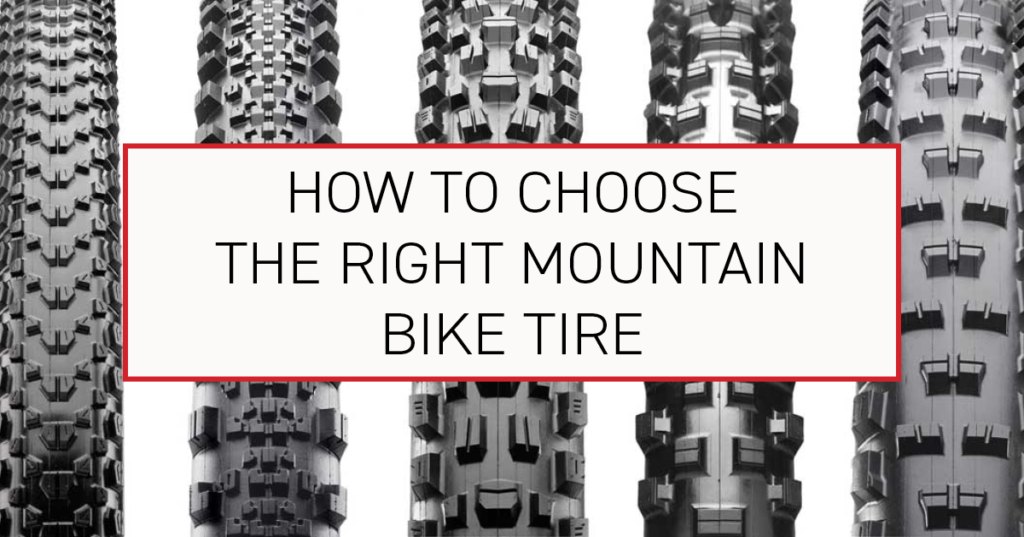How to Choose the Right Mountain Bike Tire
When choosing a mountain bike tire, there are several factors to consider:
1. Terrain
Different tires are designed for different types of terrain. For example, tires with larger knobs are better for loose and rocky terrain, while tires with smaller knobs are better for hardpacked and smooth terrain. Here is a further breakdown on the different types of tires to be used in various terrains.
- Hardpack: Tires with smaller knobs and a less aggressive tread pattern are best for hardpacked and smooth terrain, as they provide less rolling resistance and a faster ride.
- Loose: Tires with larger knobs and a more aggressive tread pattern are best for loose and rocky terrain, as they provide better traction and stability.
- Mud: Tires with deep, widely spaced knobs are best for muddy terrain, as they help to clear mud and provide traction.
- Sand: Tires with large knobs and spaced-out treads are best for sandy terrain, as they provide flotation and grip.
- Snow: Specialized tires with metal studs or wider and taller knobs are designed for snowy conditions, as they provide better traction and stability on snow and ice.
It's worth noting that some tires have a versatile tread pattern that can handle different types of terrains, such as intermediate terrains. It's always good to experiment with different tires to find the best one for your specific riding conditions.
2. Width
Mountain bike tires come in different widths, and the right width for you will depend on the type of riding you plan to do. Wider tires provide better traction, but they also add weight and can slow you down. Narrower tires are faster, but they provide less traction.
- Narrow width: Tires that are 2.1 inches or less in width are considered narrow. These tires are lightweight and provide less rolling resistance, making them good for cross-country and endurance riding. They also tend to be faster and provide less traction.
- Medium width: Tires that are 2.2 to 2.4 inches in width are considered medium. These tires are a good compromise between weight and traction and are suitable for a wide range of riding styles. They are also good for trail riding and all-mountain riding.
- Wide width: Tires that are 2.5 inches or wider in width are considered wide. These tires provide more traction and stability, making them good for Enduro and downhill riding. They also tend to be heavier and provide more rolling resistance.
Another point to consider is that width also depends on the inner rim width of the bike, the wider the tire the wider the rim should be. Also, wider tires can run at a lower pressure which can provide a more comfortable and grippier ride.
3. Tread
The tread pattern on a mountain bike tire can have a significant impact on its performance and the type of terrain it is best suited for. Tires with a more aggressive tread pattern are designed for loose and muddy conditions, while tires with a less aggressive tread pattern are designed for hardpacked and dry conditions.
- Low-profile, low-knob: Tires with a low-profile, low-knob tread pattern are best for hardpacked and smooth terrain, as they provide less rolling resistance and a faster ride. They are also good for cross-country and endurance riding.
- Intermediate, medium-knob: Tires with an intermediate, medium-knob tread pattern are a good compromise between weight and traction and are suitable for a wide range of riding styles and terrain types. They are good for trail riding, all-mountain riding, and even some light enduro.
- High-knob: Tires with a high-knob tread pattern are best for loose and rocky terrain, as they provide better traction and stability. They are also good for enduro and downhill riding.
- Mud specific: Tires with deep, widely spaced knobs are best for muddy terrain, as they help to clear mud and provide traction.
- Sand specific: Tires with large knobs and spaced-out treads are best for sandy terrain, as they provide flotation and grip.
It's important to take into account that some tires have a versatile tread pattern that can handle different types of terrains, such as intermediate terrains. It's always good to experiment with different tires to find the best one for your specific riding conditions.
4. Durability
Durability is an important factor to consider when choosing a mountain bike tire. Here are a few things to look for when evaluating the durability of a tire:
- Puncture-resistant sidewalls: Tires with reinforced sidewalls are more resistant to punctures and cuts, which can help to prolong the life of the tire.
- Durable rubber compound: Tires made with a durable rubber compound will last longer and be more resistant to wear and tear. Look for tires that use high-quality rubber compounds such as dual or triple compound technology.
- Reinforced casings: Tires with reinforced casings are more resistant to tears and punctures, which can help to prolong the life of the tire.
- Quality construction: Tires that are well-constructed with quality materials will be more durable and resistant to wear and tear.
- Brand reputation: Some brands such as Maxxis and Schwalbe have a reputation for producing high-quality, durable tires. Researching and reading reviews from other riders can also give you an idea of the durability of a tire.
Keep in mind that a tire that is durable may not have the best performance in terms of traction or rolling resistance and vice versa. Finding the right balance between durability and performance is key. Look for tires that are made with durable materials, such as puncture-resistant sidewalls and reinforced casings.
5. Your riding style
Are you an aggressive rider or a casual rider? Different mountain bike riding styles require different types of bikes and equipment, including tires. Here are a few common mountain biking styles and the types of tires that are best suited for them:
- Cross-country (XC) riding: This type of riding involves long distances on a variety of terrain types, including smooth, hard-packed trails, gravel roads, and some technical sections. Tires for XC riding should be lightweight and have a low-profile, low-knob tread pattern for minimal rolling resistance and maximum speed.
- Trail riding: This type of riding involves a mix of technical and non-technical terrain, including smooth and rocky trails, as well as some short climbs and descents. Tires for trail riding should have a versatile tread pattern with intermediate, medium-knob tread pattern that can handle different types of terrain.
- Enduro and all-mountain riding: This type of riding involves technical terrain and long descents, as well as some short climbs. Tires for enduro and all-mountain riding should have a high-knob tread pattern for maximum traction and stability, with reinforced casings and durable rubber compounds.
- Downhill riding: This type of riding involves steep descents and rough, rocky terrain. Tires for downhill riding should have a high-knob tread pattern for maximum traction and stability, with reinforced casings and durable rubber compounds.
Some riders may have a combination of riding style, therefore a versatile tire that can handle different types of terrain is a good option. Also, it's always good to experiment with different tires to find the best one for your specific riding conditions and preferences.

